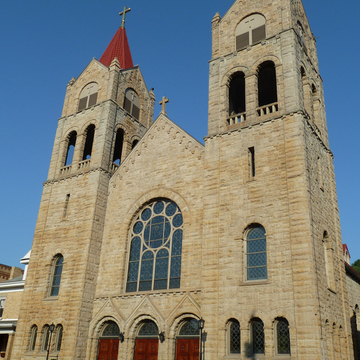Weston has had a large Roman Catholic population since the 1840s. The predecessor church to this, still standing but altered, was the town's largest when it was built in 1876. Reverend John J. Swint, later the bishop of Wheeling, deserves credit for the present massive church, which was built during the time he served as parish priest in Weston. Externally, St. Patrick's is more notable for its size than its splendor. Built of rough-faced sandstone in an uninspired Romanesque Revival style, it has a twin-towered facade. Roofs of the identical towers and the long, sloping roof of the nave, which continues downward over the aisles, are covered with bright red tiles.
Compared with the mundane exterior, the interior is extraordinry. The basilican arrangement uses the Corinthian order of the Baths of Caracalla (third century A.D.). Richly carved and gilded columns carry full impost-block entablatures that support the arches at their springing line. The nave is five bays long, although the narthex is contained within the rear bay at first-floor level. Huge, round-arched aisle windows, four to a side, have stained glass depictions of events in the life of Christ. The facade window lighting the choir loft above the narthex fittingly shows St. Cecilia, patron saint of music, seated at an organ. Only the rounded, apsidal chancel seems a bit understated, perhaps because its original altar and fittings have been replaced.
A number of parish buildings, including rectory and school, surround the church. Those that are of the same vintage as the church were also designed by Breternitz, who practiced in








